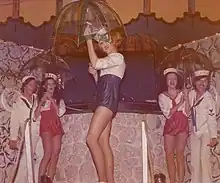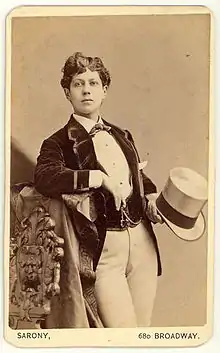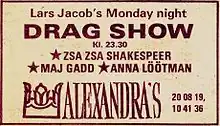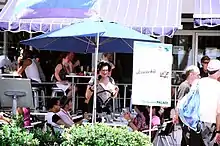Drag show
A drag show is a form of entertainment performed by drag artists impersonating men or women, typically in a bar or nightclub. Shows can range from burlesque-style, adult themed nightclub acts to all-ages events with sing-alongs and story times.

| Cross-dressing |
|---|
The modern drag show originated in the speakeasies and underground bars of 1920's and 1930's Prohibition America, in what was known as the Pansy Craze. Drag became a part of gay culture and a form of entertainment usually enjoyed by adults in bars.[1]
Typically, a drag show involves performers singing or lip-synching to songs while performing a pre-planned pantomime or dancing. There might also be some comedy, skits, and audience interaction. The performers are often given cash tips by the audience members.[2] The performers often don elaborate costumes and makeup, and sometimes dress to imitate various famous opposite sex singers or personalities. Young male dancers have often been included. Some events are centered around drag, such as Southern Decadence where the majority of festivities are led by the Grand Marshals, who traditionally are drag queens.[3]
History and development
Early existence

Instances of drag have been recorded well before drag shows began. There have been independent examples of drag in England and China in the 1500s. Since women were not allowed to participate in drama or theater, men impersonated women when acting on stage.[4] In the Victorian period English actresses impersonated men in theater, and in America actresses like Annie Hindle also impersonated men in her performances. She had a low voice and shaved regularly her facial hair to cause it to form a stubble.[4] The impersonation of the opposite sex was popular in theater and film until 1933 when the Hollywood Motion Picture Production Code was passed.[4] This law or code was aimed at eliminating what it saw as perversion and disallowed men impersonating women in film, temporarily ending the era of male impersonation in film and theater.
The first known drag balls in the United States were in Harlem in the 1920s, at the Rockland Palace.[5] These shows featured extravagant performances of gays and lesbians impersonating the opposite sex and competing against one another in fashion shows. Harlem drag balls were primarily made up of people of color. White people were not excluded but did not typically participate. Drag balls were social events that brought people together who were on the margins of society and they often had to meet in secret.[5]
Women of the Harlem Renaissance like Gladys Bentley, a prominent Blues singer, regularly wore tuxedos and dressed in men's clothing while performing.[4] Butch African American women constructed their own forms of masculinity inside and outside of Blues performances which set the stage for future performers in drag. It was not until about 50 years later that the term drag king was coined and performances started popping up across the United States. According to Elizabeth Ashburn, "A drag king is anyone, regardless of gender or sexual preference or orientation, who consciously makes a performance of masculinity."[6] Therefore, drag performers of the drag king scene typically identify as women, but some may be cisgender men or transgender men.
During World War II, parody drag shows were also a regular kind of entertainment for soldiers who dressed up as humorous-looking women and put on shows for each other.[7]
Jewel Box Revue
Doc Benner, and Danny Brown produced the show which started in Miami, Florida, at a gay bar known as Club Jewel Box.[8] This show would go on to set the stage for the touring drag show known as the Jewel Box Revue. The Jewel Box Revue was the longest running drag show that performed from the 1940s until the 1970s across the United States. They had at least ten specific performances in their repertoire, which was helpful for shows that ran for longer periods of time at the same place.[8] The show had their own music and dances that were composed and choreographed for performers, they also did comedy sketches and some stand-up performances.[8] The revue was made up of a diverse group that included African Americans, Latinos, Native Americans, and whites, which was unusual for the times before the Civil Rights Movement.
From 1955 to 1969 the Master of Ceremonies and only drag king of the revue was biracial, butch lesbian Stormé DeLarverie, whose June, 1969 scuffle with police was, according to DeLarverie and many eyewitnesses, the spark that ignited the Stonewall uprising in New York City's Greenwich Village.[9][10][11][12][13]
Many of the venues they performed at were part of the "chitlin' circuit", the Howard Theatre (Washington, D.C.), the Baltimore-Royal Theatre, Uptown Theatre (Philadelphia) and the Regal Theater in Chicago. In 1959 they began performing at The Apollo Theater in New York City and it was always a full house when they came to town.[8]
In the 1960s laws and regulations were put in place against cross-dressing and the Jewel Box Revue slowed down a bit. Although places like Los Angeles had bans in place they were still allowed to play at certain theaters.[8] Ultimately the laws and regulations against cross-dressing made it difficult for the Jewel Box Revue to perform.
In 1975, the Jewel Box Revue performed for the last time in a production at the Bijou Theater in New York City.[8]
In 1987 Michelle Parkerson released the first cut of the movie, Stormé: The Lady of the Jewel Box, about DeLarverie and her time with the revue.[13]
Pearl Box Revue
In 1955 the Pearl Box Revue began its performances in New York City. Pearl Box Revue was an all Black drag show that ran for twenty seven years until 1982.[8] Dorian Corey was a performer in the Pearl Box Revue and also one of the drag queens in the documentary by Jennie Livingston known as Paris is Burning.[8]
Disposable Boy Toys
Disposable Boy Toys (DBT) were a drag king group out of Santa Barbara, California.[14] The group was started in May 2000 and had 31 members, mostly white, queer and transgender, and were a feminist collective.[14] Their performances were centered on dismantling racism, sexism, gender binaries, ideal bodies and even militarism and they mostly performed in queer spaces or progressive spaces for fundraising and marches.[14] Lip synching and dancing were regular components of their shows. DBT was known for performing at benefits to raise money for political and community causes.[14]
DBT disbanded in August 2004, and although they did not officially break up they never performed together again.[14]
After Dark

After Dark was a Swedish group founded in 1976 which performed for over 40 years, mostly in Sweden, but intermittently also in the United States and Spain.
Provincetown, Massachusetts
Provincetown, Massachusetts, is home to some of the most famous drag performers and in the summers months there are several performances on any given night. On July 24, 2018, Provincetown was home to the first ever Drag Camp, a camp for drag performers to hone their skills and perform for live audiences.[15] The camp lasted for two weeks (until August 4, 2018) and showcased famous drag performers.[15] Jinkx Monsoon, Peaches Christ, and Raja were some of the most famous drag performers who attended Drag Camp and had their own workshops sessions on how to apply makeup, or comedic performance, amongst many others.[15] The drag performances in Provincetown, also known as Ptown, are legendary, hence why Drag Camp landed there.
Drag brunch

A drag brunch is a type of drag show in which drag kings and drag queens perform for an audience while the audience is served typical brunch foods and drinks.[16][17] The events feature dance, song and comedy performances.[18]
Although typically held at LGBTQ bars and nightclubs, restaurants have also become a popular site for drag brunches.[16][19] The practice is especially popular in urban centers with large gay populations, such as cities like New York City, Miami, Atlanta, Las Vegas, Quebec, and New Orleans.[16][19] Drag historian and New York University professor, Joe E. Jeffreys, believes that the drag brunch's rise in popularity has been due to LGBTQ venues that arose between the 1950s and 1990s, such as Lucky Cheng's, Lips NYC, and Club 82.[16] In an article titled "The Importance of Drag Brunch in NYC", Jefferys described how these venues have the ability to expose new audiences to drag performance.[16] "[People] are able to sit at drag brunch and have a lovely spinach frittata and Bloody Mary while learning this lesson through observation. They start to understand that gender and drag aren't these scary things," said Jeffreys.[16][20] "It's fun and festive like brunch can be."[16]
Gospel-themed drag brunches have been staged across the United States. The drag venue Lips first started gospel drag brunches in Fort Lauderdale, Florida in 2007.[21][22] Other places, such as San Antonio, Texas, have also seen a rise in gospel drag brunches.[23] In addition to food, drinks, and the usual performances one would expect to see at a drag brunch, gospel drag brunches also feature performers in choir robes doing renditions of classic gospel songs.[21][22][24]
Popular culture

Drag shows have become more popular with the documentary Paris is Burning, and shows like RuPaul's Drag Race. Films such as The Birdcage and Too Wong Fu, Thanks for Everything Julie Newmar have popularized drag culture too.[7] These films along with RuPaul's Drag Race have a large heterosexual fanbase.[25] Both the stage musical and film version of A Chorus Line reference drag shows, with the character of Paul relating his experiences as a performer with the touring company of the Jewel Box Revue.
See also
References
- "The Evolution Of The Art Of Drag In 33 Stunning, Historical Images". allthatsinteresting.com. 2018-12-15. Retrieved 2023-02-24.
- "How to Navigate a Drag Show When It's Your First Time". Study Breaks. 2019-04-09. Retrieved 2020-12-17.
- "Southern Decadence Official Website". Southerndecadence.net. 2013-09-03. Retrieved 2014-03-01.
- Halberstam, Judith (1997). "Mackdaddy, Superfly, Rapper: Gender, Race, and Masculinity in the Drag King Scene". Social Text (52/53): 105–131. doi:10.2307/466736. JSTOR 466736.
- Wilson, James F. (2010). "'That's the Kind of Gal I Am': Drag Balls, 'Sexual Perversion,' and David Belasco's Lulu Belle". Bulldaggers, Pansies, and Chocolate Babies: Performance, Race, and Sexuality in the Harlem Renaissance. University of Michigan Press. pp. 79–111. doi:10.3998/mpub.1175684. ISBN 978-0-472-11725-3. JSTOR 10.3998/mpub.1175684.6.
- Ashburn, Elizabeth (2015). "Drag Shows: Drag Kings and Male Impersonators" (PDF). GLBTQ Archive.
- Kaminski, Elizabeth; Taylor, Verta (2008). "'We're Not Just Lip-Synching Up Here': Music and Collective Identity in Drag Performances". In Reger, Jo; Myers, Daniel J.; Einwohner, Rachel L. (eds.). Identity Work in Social Movements. University of Minnesota Press. pp. 47–76. ISBN 978-0-8166-5139-9. JSTOR 10.5749/j.ctttt85v.6.
- Coleman, Bud (1997). "Jewel Box Revue: America's Longest-Running Touring Drag Show". Theatre History Studies. 17: 79–91. ProQuest 1311934985.
- Yardley, William (May 29, 2014) "Storme DeLarverie, Early Leader in the Gay Rights Movement, Dies at 93" in The New York Times.
- K, Kristi (May 28, 2014). "Something Like A Super Lesbian: Stormé DeLarverie (In Memoriam)". thekword.com. Archived from the original on September 3, 2014. Retrieved March 22, 2015.
- "K. Stormé DeLarverie, "Storme on Stonewall"". STONEWALL Veterans' Association. Retrieved December 30, 2018.
- Chu, Grace (July 26, 2010). "From the Archives: An interview with lesbian Stonewall veteran Stormé DeLarverie". AfterEllen.com. Retrieved October 11, 2017.
- "Women Make Movies | Storme The Lady of the Jewel Box". Wmm.com. n.d. Retrieved August 1, 2010.
- Shapiro, Eve (2007). "Drag Kinging and the Transformation of Gender Identities". Gender and Society. 21 (2): 250–271. doi:10.1177/0891243206294509. JSTOR 27640961. S2CID 145789681.
- "Provincetown Will Host the First-Ever 'Drag Camp' Featuring Some of the World's Most Famous Queens". Hornet Stories. 2018-07-17. Retrieved 2018-10-31.
- "The Importance of Drag Brunch in NYC". Food & Wine. Retrieved 2018-04-22.
- Jordan, Susan (2014). "Brunch". Empty Closet.
- "Dragging Herself To Brunch | New Haven Independent". New Haven Independent. 2015-06-19. Retrieved 2018-04-22.
- "South End club will become Charlotte's first drag queen restaurant". charlotteobserver. Retrieved 2018-04-29.
- Kravitz, Melissa (2018-04-16). "The Best Places to Catch Live Drag Shows in New York City". Thrillist. Retrieved 2018-04-22.
- Fortino, A. Sebastian. "Lips Gospel Brunch: Drag for Jesus". Retrieved 2018-04-22.
- "1. Lips". BizBash. Retrieved 2018-04-22.
- Walker, Bonnie (May 17, 2002). "W.D. Deli brunch anything but drag". San Antonio Express-News.
- Burgos, J. (2016). "Brunch at Lips is such a Drag!". Hotspots Magazine. Vol. 3124. pp. 112–113.
- "Are straight people 'stealing' RuPaul's Drag Race?". Radio Times. Retrieved 2020-12-17.